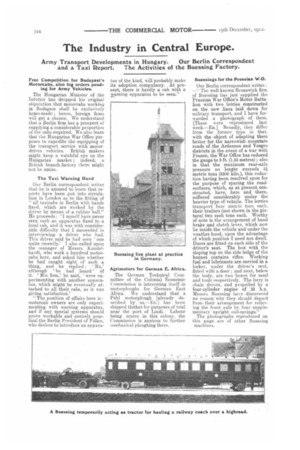The Industry in Central Europe.
Page 8

If you've noticed an error in this article please click here to report it so we can fix it.
Army Transport Developments in Hungary. Our Berlin Correspondent and a Taxi Report. The Activities of the Buessing Factory.
Free Competition for Budapest's Motorcabs, also big orders pending for Army Vehicles.
The Hungarian Minister of the Interior has dropped his original stipulation that. motorcabs working in Budapest shall be exclusively home-made ; hence, foreign firms will get a chance. We understand that a Berlin firm has a prospect of supplying a considerable proportion of the cabs required. We also learn that the Hungarian War Office purposes to expedite the equipping of the transport service with motordriven vehicles. British makers might keep a watchful eye on the Hungarian market ; indeed, a British branch-factory there might not be amiss.
The Taxi Warning Hand Our Berlin correspondent writes that he is amused to learn that reports have been put into circulation in London as to the fitting of "all taxicabs in Berlin with hands fixed, which are worked by the driver by means of a rubber ball." He proceeds : "I myself have never seen such an apparatus fixed to a local eah, and it was with considerable difficulty that I succeeded in interviewing a, driver who had. This driver said he had seen one quite recently.' I also called upon the manager of Messrs. liandelhardt, who work a hundred motorcabs here, and asked him whether be had caught sight of such a thing, and he replied : No,' although 'he had heard' of
it. His firm,' he said, were experimenting with another apparatus. which might be eventually attached to all their cabs, as it was giving satisfaction.' " The position of affairs here is : inotorcab owners are only experimenting with warning apparatus, and if any special systems should prove workable and entirely practical the Berlin President of Police, who desires to introduce an appara
tus of the kind, will probably make its adoption compulsory. At present, there is hardly a cab with a warning apparatus to be seen."
Agrimotors for German E. Africa.
The German Technical Committee of the Colonial Economic Commission is interesting itself in inotorploughs for German East Africa. We understand that a Pohl inotorplough [already described by us.—En.] has been shipped thither for purposes of trial near the port of Lindi. Labour being scarce in this colony, the Commission is anxious to further mechanical ploughing there. Buessings for the Prussian W.O.
Our Berlin correspondent writes : The well-known Brunswick firm of Buessing has just supplied the Prussian War Office's Motor Battalion with two lorries constructed on the new lines laid down for military transport, and I have forwarded a photograph of them. [These were reproduced last week.—En.] Broadly, they differ from the former type in that, with the object of adapting them better for the narrowish mountain roads of the Ardennes and Vosges districts in the event of a war with France, the War Office has reduced the gauge to 5 ft. (1.55 metres); also in that the maximum rear-axle pressure no longer exceeds 54 metric tons (MOO kilo.), this reduction having been resolved upon for the purpose of sparing the roadsurfaces, which, as at present constructed, have, here and there, suffered considerably under the heavier type of vehicle. The lorries transport four metric tons each, their trailers (not shown in the picture) two such tons each. Worthy of note is the arrangement of hand brake and clutch lever, which now lie inside the vehicle and under the weather-hood, upon the advantage of which position I need not dwell. Doors are fitted on each side of the driver's seat. The box with the sloping top on the side ledge of the bonnet contains rifles. Working fuel and lubricants are carried in a locker, under the driver's seat, fitted with a door ; and next, below the body, are two boxes for sand and tools respectively. The lorry is chain driven, and propelled by a four-cylinder engine of 35 h.p. Messrs. Bliessing have discovered no reason why they should depart from their arrangement for relieving the front axle by four supplementary upright coil-springs."
The photographs reproduced on this page are of other Buessing machines.




















